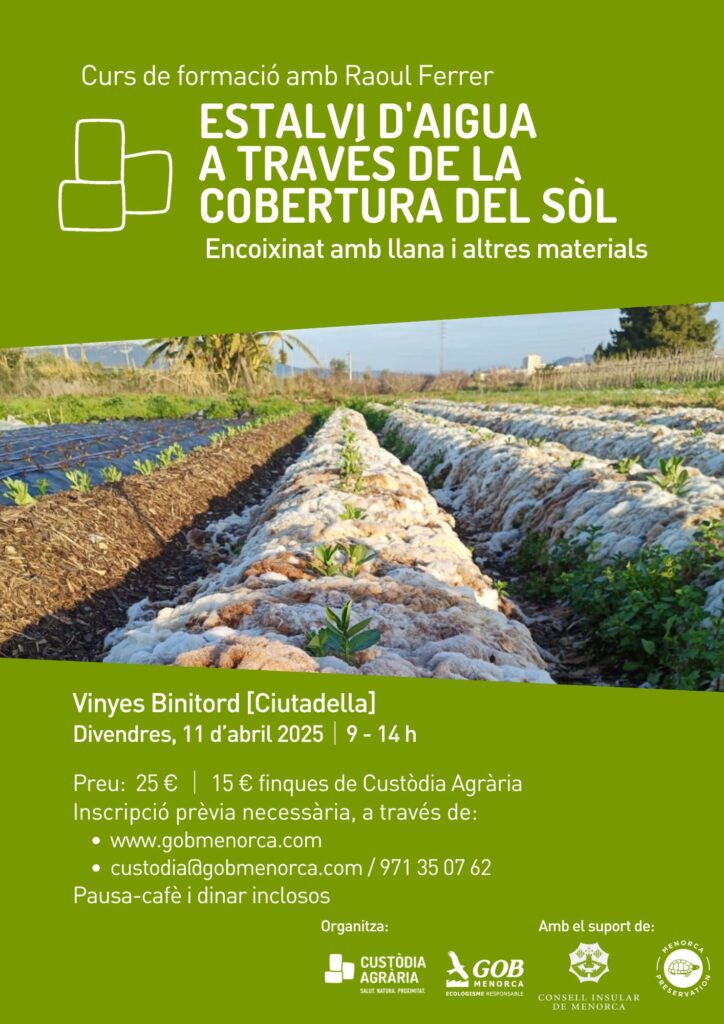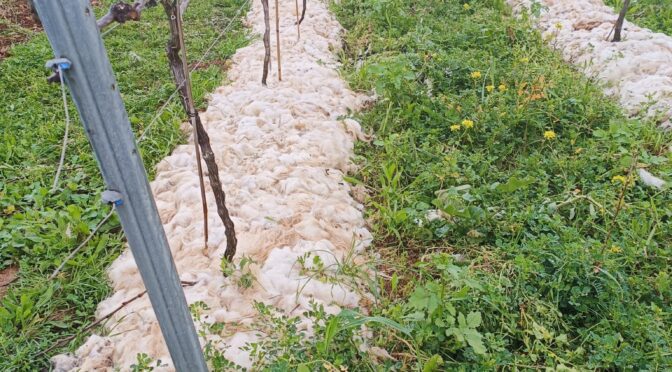Views: 1177
Mulching the soil: less evaporation, more fertility
Next Friday, April 11, GOB Menorca is organizing a training session entitled “Saving water with soil mulching”, which will take place at the Binitord vineyards (Ciutadella). The course is aimed at farmers, horticulturists, and people interested in sustainable soil management. It will include both theoretical and practical components.
The session will be led by Raoul Ferrer, an agricultural engineer with expertise in regenerative agriculture and holistic management. We spoke with him to learn more about mulching and its applications.
What is mulching, and what are its main benefits?
Mulching consists of covering the soil surface. It is a technique with multiple uses: it allows the soil to retain rainwater and irrigation water, reduces evaporation, and contributes to improving the soil’s structure and health, particularly its biological life, both macro and micro.
Why is it particularly important in the current context?
In a scenario of increasing droughts due to climate change, it’s essential to optimize water use. Even if the annual volume of rainfall doesn’t change much, it tends to fall in shorter, more intense episodes or with longer dry intervals. In both cases, it is crucial to retain water. At the same time, mulching improves soil fertility by gradually breaking down and returning nutrients to the soil.
Is it a new technique?
Not at all. Mulching has deep roots in traditional knowledge. What’s new is our growing understanding of soil biology and the availability of tools that help us fine-tune decisions. We now know more about microbial life and about how plants and soil interact; this knowledge allows us to make better-informed choices.

What materials can be used for mulching?
The course will discuss the advantages and disadvantages of various options such as straw, wood chips, bioplastics, and sheep’s wool. Each material behaves differently. Straw decomposes quickly and provides organic matter; wood chips have more carbon and need to be applied at the right time to avoid nitrogen lock-up; bioplastics can raise soil temperature but leave residues. The key is to know your context and choose accordingly.
Wool as mulch? Really?
Yes, wool is one of the most innovative materials Raoul has been experimenting with over the past three years. It’s slow to decompose, retains moisture well, and contributes nutrients. It also offers an outlet for a material with little commercial value today. At Binitord, a pilot project is already using wool for vines, a project that participants in the course will get to see first-hand.
Can wool work in Mediterranean climates like Menorca?
Yes. In addition to Binitord, wool has been tested in olive groves and lettuce crops with good results. Other projects are appearing across Spain. A new study will soon be launched in Teruel focused on valorizing wool for agricultural use.
What would you say to farmers who are skeptical?
Mulching can work for any crop and farm; it’s just a matter of choosing the right material and method. Knowing your soil, your crops, and your objectives is essential. The course will help provide the tools to make the best decision in each case.
Can wool also be used in seedbeds?
Yes, the course will include a hands-on demonstration on using wool in seedling trays. It improves the structure of young plants and provides benefits when transplanting into the soil.
Tell us about the philosophy behind the use of sheep’s wool in agriculture.
Wool is currently discarded by many farmers. But it can become a valuable agricultural resource. Thus, it is a circular solution. This is one of the principles of regenerative agriculture and holistic management: working without chemicals, saving water, and turning local waste into resources.
Would you like to encourage potential regenerative agriculture participants to enroll in the course?
If you are interested in the mulching technique, if you find the use of wool in agriculture interesting and would like to know more… do not miss this course. You will come away with many interesting ideas and proposals to apply to your crops. You will gain the ability to decide independently, according to your situation, which mulching technique can benefit you the most. And, above all, you will improve your soils, be more resilient to climate change and be more efficient in the capture, infiltration and use of water.
Don’t think twice and, if you haven’t already, sign up for the course on saving water through soil cover! Just fill out the following form: https://forms.gle/3vwm8qngAJ34gy6S9


